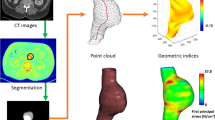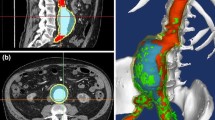Abstract
Current diagnostic testing for cardiovascular pathology usually rests on either physiological or anatomic measurement. Multiple tests must then be combined to arrive at a conclusion regarding treatment of a specific pathology. Much of the diagnostic decisions currently made are based on rough estimates of outcomes, often derived from gross anatomic observations or extrapolation of physical laws. Thus, intervention for carotid and coronary disease is based on estimates of diameter stenosis, despite data to suggest that plaque character and lesion anatomy are important determinants of outcome. Similarly, abdominal aortic aneurysm (AAA) intervention is based on maximal aneurysm diameter without regard for arterial wall composition or individual aneurysm geometry. In other words, our current diagnostic tests do not reflect the sophistication of our current knowledge of vascular disease. Using a multimodal approach, computer modeling has the potential to predict clinical outcomes based on a variety of factors including arterial wall composition, surface anatomy and hemodynamic forces. We term this more sophisticated approach “patient specific diagnostics”, in which the computer models are reconstructed from patient specific clinical visualizing modalities, and material properties are extracted from experimental measurements of specimens and incorporated into the modeling using advanced material models (including nonlinear anisotropic models) and performed as dynamic simulations using the FSI (fluid structure interaction) approach. Such an approach is sorely needed to improve the effectiveness of interventions. This article will review ongoing work in “patient specific diagnostics” in the areas of carotid, coronary and aneurismal disease. We will also suggest how this approach may be applicable to management of aortic dissection. New diagnostic methods should allow better patient selection, targeted intervention and modeling of the results of different therapies.





Similar content being viewed by others
References
Beneficial effect of carotid endarterectomy in symptomatic patients with high-grade carotid stenosis (1991) North American Symptomatic Carotid Endarterectomy Trial Collaborators. N Engl J Med 325:445–453
Bettermann K, Toole JF (2005) Diagnostic evaluation and medical management of patients with ischemic cerebrovascular disease. In: Rutherford RB (ed) Vascular surgery. Elsevier, Philadelphia 1904–1905
Bluestein D, Yared A, Avrahami I, Dumont K, Gharib M, Ricotta J, Einav S (2008) Influence of microcalcifications on vulnerable plaque mechanics using FSI modeling. J Biomech 41:1111–1118. doi:10.1016/j.jbiomech.2007.11.029
Bluestein D, Dumont K, De Beule M, Ricotta J, Impellizzeri P, Verhegghe B, Verdonck P (2008) Intraluminal thrombus and risk of rupture in patient specific abdominal aortic aneurysm—FSI modeling. Comput Methods Biomech Biomed Engin 27:1–9. doi:10.1080/10255840802176396
Eggebrecht H, Nienaber CA, Neuhauser M, Baumgart D, Kische S, Schmermund A, Herold U, Rehders TC, Jakob HG, Erbel R (2006) Endovascular stent-graft placement in aortic dissection: a meta-analysis. Eur Heart J 27:489–498. doi:10.1093/eurheartj/ehi493
Endarterectomy for asymptomatic carotid stenosis (1995) Executive Committee for the Asymptomatic Carotid Atherosclerosis Study. JAMA 273:1421–1428. doi:10.1001/jama.273.18.1421
Fillinger M (2006) The long-term relationship of wall stress to the natural history of abdominal aortic aneurysm (finite element analysis and other methods). Ann NY Acad Sci 1085:22–28. doi:10.1196/annals.1383.037
Finet G, Ohayon J, Rioufol G (2004) Biomechanical interactions between cap thickness, lipid core composition and blood pressure in vulnerable coronary plaque: impact on stability or instability. Coron Artery Dis 15:13–20. doi:10.1097/00019501-200402000-00003
Fukumoto Y, Hiro T, Fujii T et al (2008) Localized elevation of shear stress is related to coronary plaque rupture: a 3-dimensional intravascular ultrasound study with in-vivo color mapping of shear stress distribution. J Am Coll Cardiol 51:645–650. doi:10.1016/j.jacc.2007.10.030
Grogan JK, Skaalan WE, Cheng H et al (2005) B-mode ultrasonographic characterization of carotid atherosclerotic plaques in symptomatic and asymptomatic patients. J Vasc Surg 42:435–441. doi:10.1016/j.jvs.2005.05.033
Hagan PG, Nienaber CA, Isselbacher EM, Bruckman D, Karavite DJ, Russman PL, Evangelista A, Fattori R, Suzuki T, Oh JK, Moore AG, Malouf JF, Pape LA, Gaca C, Sechtem U, Lenferink S, Deutsch HJ, Diedrichs H, Marcos y Robles J, Llovet A, Gilon D, Das SK, Armstrong WF, Deeb GM, Eagle KA (2000) The International Registry of Acute Aortic Dissection (IRAD): new Insights into an old disease. JAMA 283:897–903. doi:10.1001/jama.283.7.897
Halliday A, Mansfield A, Marro J, Peto C, Peto R, Potter J, Thomas D (2004) Prevention of disabling and fatal strokes by successful carotid endarterectomy in patients without recent neurological symptoms: randomized controlled trial. Lancet 363:1491–1502. doi:10.1016/S0140-6736(04)16146-1
Hennerici MG (2004) The unstable plaque. Cerebrovasc Dis 17(Suppl 3):17–22. doi:10.1159/000075300
Hua J, Mower WR (2001) Simple geometric characteristics fail to reliably predict abdominal aneurysm wall stresses. J Vasc Surg 34:308–315. doi:10.1067/mva.2001.114815
Imoto k, Hiro T, Fujii T et al (2005) Longitudinal structural determinants of atherosclerotic plaque vulnerability: a computational analysis of stress distribution using vessel models and three dimensional ultrasound imaging. J Am Coll Cardiol 46:1507–1515
Kakkos SK, Stevens JM, Nicolaides AN, Kyriacou E, Pattichis CS, Geroulakos G, Thomas D (2007) Texture analysis of ultrasonic images of symptomatic carotid plaques can identify those plaques associated with ipsilateral embolic brain infarction. Eur J Vasc Endovasc Surg 33:422–429. doi:10.1016/j.ejvs.2006.10.018
Kern MJ, Lerman A, Bech JW, De Bruyne B, Eeckhout E, Fearon WF, Higano ST, Lim MJ, Meuwissen M, Piek JJ, Pijls NH, Siebes M, Spaan JA (2006) Physiological assessment of coronary artery disease in the cardiac catheterization laboratory: scientific statement from the American Heart Association Committee on Diagnostic and Interventional cardiac Catheterization, Council on Clinical Cardiology. Circulation 114:1321–1341. doi:10.1161/CIRCULATIONAHA.106.177276
Lederle FA, Wilson SE, Johnson GR, Reinke DB, Littooy FN, Acher CW, Ballard DJ, Messina LM, Gordon IL, Chute EP, Krupski WC, Busuttil SJ, Barone GW, Sparks S, Graham LM, Rapp JH, Makaroun MS, Moneta GL, Cambria RA, Makhoul RG, Eton D, Ansel HJ, Freischlag JA, Bandyk D, Aneurysm Detection Management Veterans Affairs Cooperative Study Group (2002) Immediate repair compared with surveillance of small abdominal aortic aneurysms. N Engl J Med 346:1437–1444. doi:10.1056/NEJMoa012573
Li ZY, Howarth SPS, Tang T, Gillard J (2006) How critical is fibrous cap thickness to carotid plaque stability? A flow plaque interaction model. Stroke 37:1195–1199. doi:10.1161/01.STR.0000217331.61083.3b
Makamura T, Obata JE, Kitta Y et al (2008) Rapid stabilization of vulnerable carotid plaque within one month of treatment in patients with acute coronary syndrome. J Cardiovasc Pharmacol 51:365–371. doi:10.1097/FJC.0b013e318165dcad
Meuwissen M, Chanuleau SA, Siebes M, de Winter RJ, Koch KT, DIjskman LM, van den Berg AJ, Tijssen JG, Spaan JA, Piek JJ (2008) The prognostic value of combined intracoronary pressure and blood flow velocity measurements after deferral of percutaneous coronary intervention. Catheter Cardiovasc Interv 71:291–297. doi:10.1002/ccd.21331
Moore WS, Hall AD (1968) Ulcerated atheroma of the carotid artery: a cause of transient cerebral ischemia. Am J Surg 116:237–242. doi:10.1016/0002-9610(68)90499-6
(1998) Mortality results for randomized controlled trial of early elective surgery or ultrasonographic surveillance for small abdominal aortic aneurysm. The UK Small Aneurysm Trial Participants. Lancet 352:1649–1655. doi:10.1016/S0140-6736(98)10137-X
National Institutes of Health (1994) National Heart, Lung, and Blood Institute report of the task force on research in epidemiology and prevention of cardiovascular diseases. In: Public Health Service
Nicolaides AN, Kakkos S, Griffin M, Geroulakos G, Ioannidou E (2005) Severity of asymptomatic carotid stenosis and risk of ipsilateral hemispheric ischaemic events: results from the ACSRS study. Eur J Vasc Endovasc Surg 30:275–284. doi:10.1016/j.ejvs.2005.04.031
Nienaber CA, Zannetti S, Barbieri B, Kische S, Schareck W, Rehders TC, INSTEAD study collaborators (2005) INvestigation of STEnt grafts in patients with type B Aortic Dissection: design of the INSTEAD trial—a prospective, multicenter, European randomized trial. Am Heart J 147:592–599. doi:10.1016/j.ahj.2004.05.060
O’Holleran LW, Kennelly MM, McClurken M, Johnson JM (1987) Natural history of asymptomatic carotid plaque. Five year follow-up study. Am J Surg 154:659–662. doi:10.1016/0002-9610(87)90238-8
Ohayon J, Finet G, Gharib AM et al (2008) Necrotic core thickness and possible arterial remodeling index: emergent biomechanical factors for evaluating the risk of plaque rupture. Am J Physiol Heart Circ Physiol 295:H717–H727. doi:10.1152/ajpheart.00005.2008
Rissland P, Alemu Y, Einav S, Ricotta J, Bluestein D (2008) Abdominal aortic aneurysm risk of rupture: patient-specific FSI simulations using anisotropic model. J Biomech Eng (in press)
Roederer GO, Langlois YE, Jager KA, Primozich JF, Beach KW, Phillips DJ, Strandness DE Jr (1984) The natural history of carotid arterial disease in asymptomatic patients with cervical bruits. Stroke 15:605–613
Rosamond W, Flegal K, Friday G, Furie K, Go A, Greenlund K, Haase N, Ho M, Howard V, Kissela B, Kittner S, Lloyd-Jones D, McDermott M, Meigs J, Moy C, Nichol G, O’Donnell CJ, Roger V, Rumsfeld J, Sorlie P, Steinberger J, Thom T, Wasserthiel-Smoller S, Hong Y, American Heart Association Statistics Committee and Stroke Statistics Subcommittee (2007) Heart disease and stroke statistics—2007 update: a report from the American Heart Association Statistics Committee and Stroke Statistics Subcommittee. Circulation 115:e69–e171. doi:10.1161/CIRCULATIONAHA.106.179918
Rothwell PM, Eliasziw M, Gutnikov SA, Fox AJ, Taylor DW, Mayberg MR, Warlow CP, Barnett HJ, Carotid Endarterectomy Trialists’ Collaboration (2003) Analysis of pooled data from the randomized controlled trials of endarterectomy for symptomatic carotid stenosis. Lancet 361:107–116. doi:10.1016/S0140-6736(03)12228-3
Schermerhorn M, Zwolak R, Velazquez O, Makaroun M, Fairman R, Cronenwett J (2008) Ultrasound screening for abdominal aortic aneurysm in medicare beneficiaries. Ann Vasc Surg 22:16–24. doi:10.1016/j.avsg.2007.07.026
Slager CJ, Wentzel JJ, Gijsen FJ, Thury A, van der Wal AC, Schaar JA, Serruys PW (2005) The role of shear stress in the destabilization of vulnerable plaques and related therapeutic implications. Nat Clin Pract Cardiovasc Med 2:456–464. doi:10.1038/ncpcardio0298
Spaan JA, Piek JJ, Hoffman JI, Siebes M (2006) Physiological basis of clinically used coronary hemodynamic indices. Circulation 113:446–455. doi:10.1161/CIRCULATIONAHA.105.587196
Truijers M, Pol JA, Schultzekool LJ, van Sterkenburg SM, Fillinger MF, Blankensteijn JD (2007) Wall stress analysis in small asymptomatic, symptomatic and ruptured abdominal aortic aneurysms. Eur J Vasc Endovasc Surg 33:401–407. doi:10.1016/j.ejvs.2006.10.009
van den Wijngaard JP, Kolyva C, Siebes M, Dankelman J, van Gemert MJ, Piek JJ, Spaan JA (2008) Model prediction of subendocardial perfusion of the coronary circulation in the presence of an epicardial coronary artery stenosis. Med Biol Eng Comput 46(5):421–432
Yusuf S, Zucker D, Peduzzi P, Fisher LD, Takaro T, Kennedy JW, Davis K, Killip T, Passamani E, Norris R et al (1994) Effect of coronary artery bypass graft surgery on survival: overview of ten-year results from randomized trials by the Coronary Artery Bypass Graft Surgery Trialists Collaboration. Lancet 344:563–570. doi:10.1016/S0140-6736(94)91963-1
Zankl AR, Schumacher H, Krumsdorf U, Katus HA, Jahn L, Tiefenbacher CP (2007) Pathology, natural history and treatment of abdominal aortic aneurysms. Clin Res Cardiol 96:140–151. doi:10.1007/s00392-007-0472-5
Author information
Authors and Affiliations
Corresponding author
Rights and permissions
About this article
Cite this article
Ricotta, J.J., Pagan, J., Xenos, M. et al. Cardiovascular disease management: the need for better diagnostics. Med Biol Eng Comput 46, 1059–1068 (2008). https://doi.org/10.1007/s11517-008-0416-x
Received:
Accepted:
Published:
Issue Date:
DOI: https://doi.org/10.1007/s11517-008-0416-x




